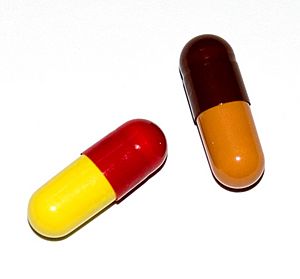Capsule facts for kids

A capsule is a common and easy way to take medication. Think of it like a small, special container for medicine. Capsules can hold different things inside, such as powder, liquid, or even oil. The outside part, or "shell," is usually made from a material called gelatin, which can be either hard or soft.
Capsules come in many different shapes and colors. These differences help people know what kind of medicine is inside, what dose to take, or which company made it. Some capsules are also designed to be "timed release." This means they slowly let out the medicine over a longer period, so you don't have to take as many pills throughout the day. It's important to always take capsules whole, unless a pharmacist or doctor tells you otherwise. You should also never crush a capsule without checking if it's safe to do so.
Contents
What Are Capsules Made Of?
Capsules have two main parts: the outer shell and the medicine inside.
The Outer Shell
The shell of a capsule is usually made from gelatin. Gelatin is a natural substance that dissolves easily in your stomach. This allows the medicine inside to be released into your body. Some capsules use plant-based materials instead of gelatin, which is helpful for people who prefer not to use animal products.
Hard-Shelled Capsules
Hard-shelled capsules are often made of two pieces that fit together. They are usually used for powdered medicines. You can often see the two halves of the capsule joined in the middle.
Soft-Shelled Capsules
Soft-shelled capsules are usually one piece and are often used for liquids or oils, like Cod liver oil or vitamin supplements. They have a smooth, soft feel and are sealed to keep the liquid inside.
The Medicine Inside
Inside the capsule, you'll find the active medicine. This can be in different forms:
- Powder: Many common medicines are in powder form inside hard capsules.
- Liquid: Some medicines, especially oils or certain solutions, are stored in soft capsules.
- Tiny Beads: For timed-release capsules, the medicine might be in tiny beads. These beads dissolve at different rates, releasing the medicine slowly over several hours.
Why Do We Use Capsules?
Capsules are a popular way to take medicine for several good reasons.
Easy to Swallow
For many people, capsules are easier to swallow than tablets, especially if the medicine has a bad taste. The smooth outer shell helps them go down easily.
Protecting the Medicine
The capsule shell protects the medicine inside from light, air, and moisture. This helps keep the medicine stable and effective until you take it. It also helps prevent the medicine from breaking down too quickly in your stomach acid before it can be absorbed.
Controlling Release
As mentioned, some capsules are designed for "timed release." This means the medicine is released slowly over hours, which can be very helpful for medicines that need to work all day or night. It also means you might not have to take the medicine as often.
Important Safety Tips for Capsules
Taking medicine safely is very important. Here are some key things to remember about capsules:
Always Take Them Whole
Unless your doctor or a pharmacist specifically tells you to, always swallow capsules whole. If you open or crush a capsule, it might change how the medicine works. For example, a timed-release capsule could release all its medicine at once, which might not be safe.
Check with an Adult or Pharmacist
If you are unsure about how to take a capsule, or if you accidentally open one, always ask a parent, guardian, or a pharmacist. They can give you the best advice.
Storage
Keep capsules in their original packaging and store them in a cool, dry place, away from direct sunlight. This helps keep them effective. Always keep all medicines out of reach of small children.
Images for kids
-
Reconstruction from µCT-data of a hard starch capsule containing Diclofenac.





